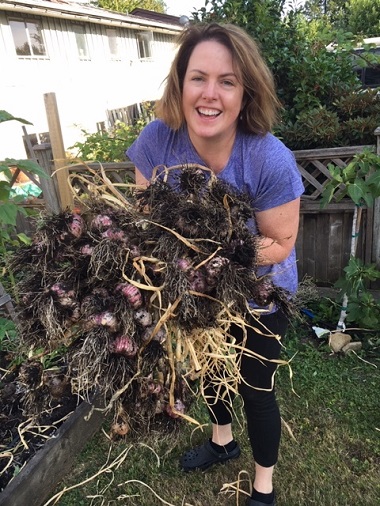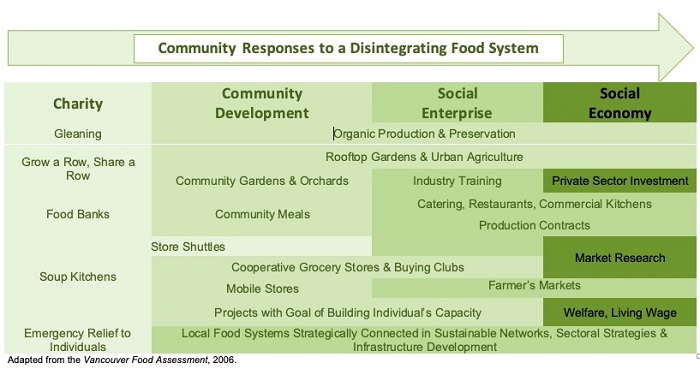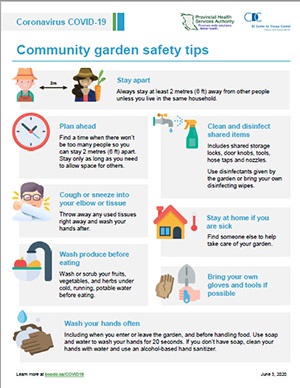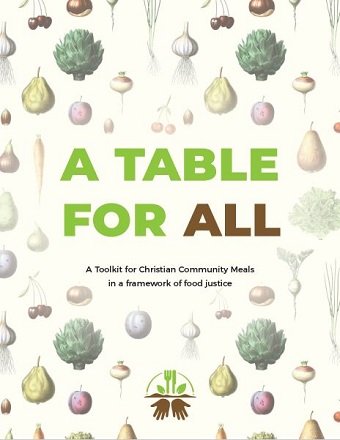
Barry and Joan Jung have several garden beds on their front boulevard. Joan holding garlic shared with neighbours.
Last week we wrote about how Vancouver churches are responding through community food programs to the physical and spiritual hunger that COVID-19 is exacerbating.
Prior to the pandemic, approximately one in 10 households in British Columbia were experiencing inadequate or insecure access to food due to financial constraints; April 2020 estimates are that one in seven Canadians are now food insecure.
This week, we will explore where community gardens and urban farms fit in the continuum of responses to food insecurity. While they may not provide the bulk of the calories we consume, they will certainly be part of the social recovery of our communities.
A Table for All: A Toolkit for Christian Community Meals in a Framework of Food Justice [produced by Karen Giesbrecht, Winston Green and two others; go here for more detail] explains that,
Given the diversity of threats to our food system and its inherent complexity, there is no single set of practices that will ensure the food security of a community. Rather, food security exists when there is a comprehensive continuum of resources in the community’s food system.[1]
As the chart indicates, that continuum may need to begin with short-term relief of acute food insecurity, but then moves on to efforts that develop the community’s capacity to feed itself, and then proceeds to re-design the entire local system in support of innovative synergies among the not-for-profit, private, and public sectors.

The continuum must be more than the sum of its parts. It yields food security to the degree its various components intentionally strengthen each other” (p 28-29).
Gardening as a spiritual practice
Thankfully, we continue to see buds of good news sprouting in Metro Vancouver’s community gardens, front yards and urban farms, contributing to our capacity to feed ourselves and our neighbours.
Enter Barry Jung. Barry and his wife Joan have invested their last few years in learning what it means to be good neighbours. One way he has done this is through his front yard. Barry began with one garden bed, and over the years has expanded to six along the boulevard.
He intentionally uses his love of being in the soil to connect with neighbours, share the fruits of his labour with neighbours and inspire the common good in his South Cambie neighbourhood. Through this simple act of building a garden, Barry has gotten to know both the earth and his neighbours better. Through spending time in his garden, those who pass by often comment or ask questions, which led to conversations that grew into relationships.
Barry’s story was recently featured as part of an online course with Christine Sine on The Spirituality of Gardening (see video).
Matt Humphrey, director of theological education for A Rocha Canada, wrote a related article which articulates how our food and faith interconnect, and where gardens fit.
Community examples
 In this season of physical distancing, we need to re-learn how to do things like community garden safely. The BC Centre for Disease Control has outlined measures necessary to operate during COVID-19.
In this season of physical distancing, we need to re-learn how to do things like community garden safely. The BC Centre for Disease Control has outlined measures necessary to operate during COVID-19.
There may still be plenty of land on church yards with growing potential, but here are some ways that faith communities are already involved in growing food locally:
- Garden of Eatin began as a community outreach project for First Christian Reformed Church of Vancouver:
We hope to unite a community of stewards, trying to experience the full generosity of God through building relationships, working together, eating well and witnessing the miracle of growth. . . .
We also maintain the ‘Grow a Row’ program where we donate fresh produce to some who live on the Downtown Eastside.
- Servants: A small Downtown Eastside community garden made from an abandoned blackberry lot:
The team committed themselves to simplifying and consolidating their lifestyles in order to be more intentional about their calling to build God’s kingdom among the poor. Community rhythms included prayer and fellowship, as well as eating and celebrating together.
By opening their home and table to their friends and neighbours they saw that the intimacy of a shared meal can forge relationships which cross social boundaries.
- Red Clover Farm: This urban farm has been running since 2005 using organic and sustainable farming practices on two lots in the Downtown Eastside:
We are an urban farm that seeks partnership in economic development. Through our ties and relationships to others in the neighbourhood we seek to help you be better connected to your food sources, and better connected to others in your city.
- City Beet Farm: A “multi-site urban farm,” providing fresh, local produce in Community Supported Agriculture (CSA) boxes in the Riley Park and Mount Pleasant areas, with a love of nutritious food and nourishing people. They recently collaborated with Tenth Church.
- A Rocha Sustainable Agriculture: A Rocha Canada began sustainable agriculture over 10 years ago in Surrey:
We’re equipping community gardeners across Canada to grow food for their less fortunate neighbours through our Community Garden Network. We’re turning schoolyards into farmyards in inner-city neighbourhoods through our Farm to Families project. . . .
Our commitment to you is to grow a variety of the healthiest and freshest vegetables possible in a way that cares well both for people and the particular patch of earth that we steward!
I (Winston) live in a co-op in the Downtown Eastside. If, statistically one out of seven experience food insecurity, out of the 60 apartments there would be eight or nine people struggling to meet their food needs. I had not thought about my community in those terms.
It is harder to find strong social connections in this neighbourhood than affordable, fresh, nutritious food. In response to both these concerns, our co-op built a few garden boxes.
Just last weekend, the organic, social interaction around the boxes was rich – we talked about how fresh smelling the tomato plants were, how the snap peas were reaching for the lattices and how the beets with their luscious leaves were popping out of the soil.
My neighbours and I were experiencing a connection with creation and each other, and swooning from how tasty our salads were that evening.
[1] Forum of Research Connections (FORC). (2006). Vancouver Food System Assessment, p 5
Karen Giesbrecht and Winston Green work with the Union Gospel Mission (UGM) church relations department (churchrelations@ugm.ca) and Planted Community Food Network.
 They wrote about community meals and the 90-page toolkit they have developed in a companion article last week. Here is a portion:
They wrote about community meals and the 90-page toolkit they have developed in a companion article last week. Here is a portion:
We are pleased to share with you the first edition of A Table for All: A Toolkit for Christian Community Meals in a Framework of Food Justice. (Download here: https://www.ugm.ca/take-action/churches/)
With this toolkit, we aim to offer you a springboard for connecting with other communities of faith as you create, host, partner or rethink community meal programs in your own context. We sincerely desire for you to know – in reading and using this guide – that you are not alone in this vital work.
This toolkit was developed collaboratively by Christ Church Anglican Cathedral, Planted Community Food Network and Union Gospel Mission (UGM). We share a commitment to modelling, teaching and accompanying other organizations as they orient their food programs towards social inclusion and deeper justice.
